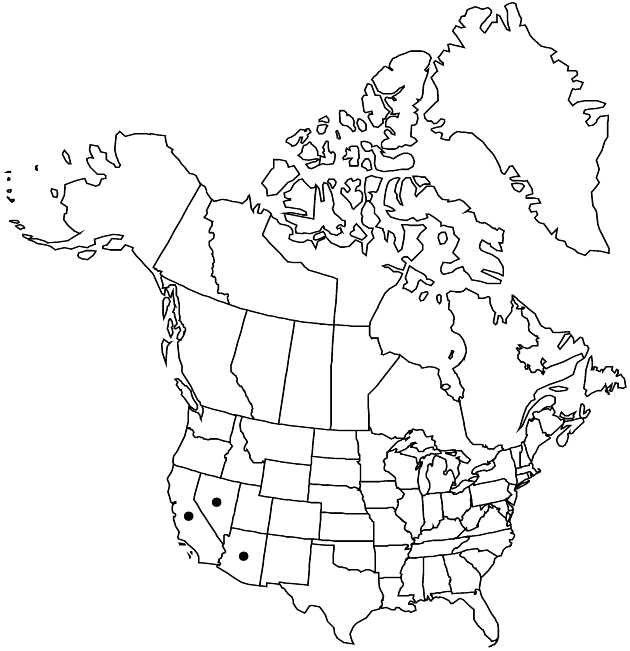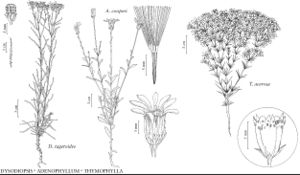Adenophyllum cooperi
Sida 11: 376. 1986.
IllustratedEndemic
Basionym: Dyssodia cooperi A. Gray Proc. Amer. Acad. Arts 9: 201. 1874
Treatment appears in FNA Volume 21. Treatment on page 239.
Perennials or subshrubs, 30–50+ cm. Leaves mostly not lobed, blades oblanceolate to ovate, 8–25 × 4–8 mm (bases sometimes toothed or obscurely lobed, oil-glands 1–2 pairs near base, 1 near tip, each leaf). Peduncles 60–150 mm. Calyculi of 12–22 linear-attenuate, gland-bearing, bractlets 5–8 mm. Involucres campanulate to obconic, 15–18 mm. Phyllaries ca. 20, lanceolate to linear, separating in fruit. Ray-florets (0–) 7–13; corollas yellow-orange, becoming red-orange; tubes 5 mm, laminae 8–10 × 2.5–4 mm. Disc-florets 50–80+; corollas yellow, 8–10 mm. Cypselae 5–7 mm; pappi of 15–20 scales 7–10 mm, each comprising 5–9, basally connate bristles. 2n = 26.
Phenology: Flowering spring–fall.
Habitat: Sandy and gravelly soils of washes and alluvial fans in deserts
Elevation: 0–1300 m
Distribution

Ariz., Calif., Nev.
Discussion
Selected References
None.
Lower Taxa
None.
... more about "Adenophyllum cooperi"
introrse +
connate +
herbaceous +
scarious +
absent +
hirsute +
papillate +
continuous +
decurrent +
oblanceolate;ovate +
winged;ribbed;winged;ribbed +
12;22 +
linear;subulate +
stigmatic +
connate +
gland-bearing +
absent +
zygomorphic +
monomorphic +
dimorphic +
obpyramidal +
5mm;7mm +
staminate +
straight +
scabrellous +
distinct +
proximal +
1;5 +
bisexual +
dispersed +
cylindric +
singly +
discoid +
singly +
indeterminate +
Present +
surrounding +
campanulate;obconic +
8mm;10mm +
2.5mm;4mm +
opposite +
cauline +
lobed +
2-carpellate +
inferior +
attached +
anatropous +
persistent +
falling +
absent +
coroniform +
tough +
thick +
absent +
connate +
separating +
persistent +
distinct +
falling +
unequal +
Sida +
1986 +
pistillate +
absent +
fertile +
epaleate +
pitted +
convex +
fibrous +
exalbuminous +
modifed +
1;2 +
alternate +
branched +
erect +
2-branched +
papillate +
Adenophyllum cooperi +
Adenophyllum +
species +
cylindric +
shorter +
much longer +
5 cm50 mm <br />0.05 m <br /> (?) +
toothed +
perennial +
subshrub +
